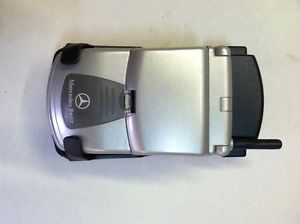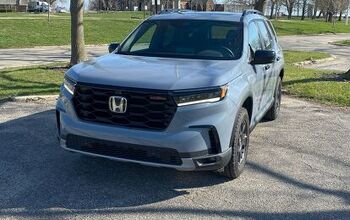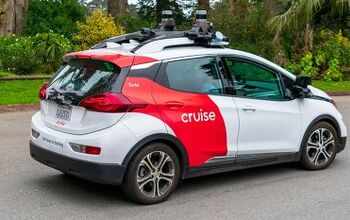Avoidable Contact: Who's Afraid of a Little Integration?

Saturday morning, I’m at Ki’s with the fellow who hired me at my day job a couple of years ago. He’s in his early fifties, considerably taller and wider than I am, cheerful in his aggressive tan and studiously thrown-together beach-bum ensemble, yet menacing enough that when he veers in the direction of a particular table on the sunporch the other two groups of people who are also heading for the table magically decide to just stand and wait for the next one instead. We don’t work together any more; he hired me to turn an idea of his into aluminum-and-silicon reality then he departed for the next idea. The future is as real to him as the present; perhaps more so. He earns between three and four hundred dollars an hour as a consultant, imagining what technology might be able to do for medicine in the future.
“You do this car thing,” he barks. “Something I’ve wondered. Bought that Rubicon outside. They wanted two thousand dollars for navigation. Now that’s a (bleep)ing waste of money. Utterly insane. Why not offer full Bluetooth integration into what my phone already does, extend the screen and the touch facility to a dash display. Cost two hundred bucks if you talk to —” And he rattles off the names of a couple of Taiwanese OEMs who could, no doubt, handle it. “Why isn’t that happening?”
“Yeah,” I agree, “that’s crazy alright.”
“I,” he growls in response, leaning back in his chair and fixing me with his eye, “was asking you a question, actually.”
As a consequence of my experience as a programmer and sysadmin, combined with my unrelenting automotive obsession, I’ve long had a fascination with in-car computing. I remember being quite indignant when the original E60 BMW iDrive turned out to be based on the late and unlamented Windows CE platform. “If they’d bother to do something with Linux and ARM,” I said, quite condescendingly, “it wouldn’t suck like it does.” Well, they did, and it still does. Oh, well. My crystal ball has always been cloudy, even if I did tell my father to buy AAPL at $20.50 a share and to take a short position in RHAT at $45.
The unfortunate truth is that the automobile has always been a poor fit with “modern” technology, whether it was the early in-car phonograph players or this abomination:
Anybody recognize that? Don’t say “It’s a silver Motorola StarTAC”, even though it basically is. It’s the Motorola Timeport, a two-thousand-dollar option for the W220 Mercedes S-Class that was “fully integrated” into the horrible COMAND system of the day. There were perhaps three months in human history when the Timeport was as good as the equivalent black StarTAC. During those three months, the black StarTAC cost three hundred bucks, which is to say it cost one-seventh of what the Timeport cost. For the next couple years, the Timeport didn’t change, but the StarTAC and its successors did. By the time Mercedes discontinued the option, it would have been an active embarrassment for any Mercedes owner to be seen with a phone like that.
Still, if you owned a W220 the Timeport remained the only way to get factory hands-free calling. If your Timeport broke, you had to go to the Benz dealer and pay $1100 for a replacement. Eventually, Motorola refused to supply any more Timeports to the M-B parts operation, which made the ones in stock even more expensive. Needless to say, the whole thing was a disaster of the first order for everyone involved. The reason was simple: even though the W220 was perhaps the worst piece of garbage to wear the three-pointed star since Karl Benz’s Patent-Motorwagen annoyed the horses, most of them still had a service life approximately ten times that of the average cellular phone.
We all intrinsically recognize that some goods are “durable” and some are not. If your grandfather got a Colt Single Action Army pistol in his youth from his grandfather, chances are it either still works or can be easily repaired to function exactly as it did in 1901. His underwear, on the other hand, is probably best handled with the robots they’re using to clean up Fukushima. Automobiles are considerably more durable than most consumer-technology devices, and they have resale value which can be adversely affected by things like cassette players built into an oval dashboard panel — hello, ’96 Taurus — or the inability to “see” SD cards larger than 2GB — yes, 2008 Audi TT, that would be you! The tech world moves much faster than the car world. If you want a stark reminder of that, consider the fact that the Bentley Continental GT of about three years ago had a lower-resolution display and less processing power than does the new Samsung GalaxyGear watch.
The smarter OEMs are wising up to the fact that they can’t keep pace with what’s happening outside the car and they’re adjusting their strategy to suit. The much-reviled myFordTouch was designed from the beginning to be easily updated with new functionality. Tesla’s simply providing Model S customers with one big touchscreen which gives them the ability to change the interface as they see fit in the future. Yet both of those approaches are also flawed, because they still rely on the car to provide the computing power behind the user experience. That means that in five years you’ll probably be able to buy a prepaid phone at WalMart for $49.99 that outpaces the processors in the $60,000-plus Tesla Model S.
It stands to reason, therefore, that the most advanced approach would be to turn the car into an interface. Give it the ability to connect with a multitude of devices on their terms, let the buyers bring what they prefer. Put the biggest touchscreen money can buy into the thing and publish the API. (The API is the set of commands and routines that programmers can use to connect with another program or device.) Imagine sitting down in the newest BMW and having the center stack be an extension of your iPhone or Android phone. When you upgrade Android, the interface also “upgrades”. When your new phone is faster than the old one, the interface in your car will also be faster.
The raw cost of a ruggedized, heat-and-cold-ready touchscreen with an Atom processor, built into a car, is well under three hundred dollars. If you’re willing to subsume the HVAC and other center stack controls into the thing — a course of action which I cannot recommend — it pays for itself in lowered cost elsewhere. You make it available to Apple and Android devices, secure in the knowledge that any competitor which appears in the next ten years will need to “play nice” with one or both of the existing standards. If a driver without a phone gets into the car, he won’t have access to music, entertainment, navigation, or certain other functions —- but in 2013, who the hell has a car but not a phone? If you’re feeling generous, you can throw in a 1/8″ input jack as well so low-cost devices all the way to the Sony FM Walkman will also work.
All of a sudden, many of your problems as a car manufacturer are a thing of the past. Your sound system becomes as advanced as the phone in the user’s pocket. Instead of having your nav system compared unfavorably to Waze or Google Maps, you can simply integrate them and take the best of everything. Your competitors might offer solid infotainment systems, but your product has exactly what each individual customer wants and has already selected. You can still make money by offering multiple levels of speaker and amplifier technology at ever-escalating prices. Your cars will be easier to insure because the thing that everybody really wants to steal has left the car in the owner’s pocket. Ten years from now, the interiors of your old models will still have the center-stack look and feel of the newest phones and operating systems. It’s such a brilliant idea I have no idea why it’s not being done in everything costing more than a Nissan Note.
Well, that’s not exactly true. I do know why it isn’t being done. It isn’t because the automakers are unable to integrate with a Bluetooth device; just look at the Lexus Enform system or myFordTouch’s ability to navigate using your phone in newer versions. It isn’t because Bluetooth isn’t high-bandwidth to handle the required traffic across the wireless bus; hell, a GoPro can use Bluetooth to convey HD-level motion images. It’s because everybody who is in the business of looking into the future sees a greater need for non-integrated electronics in the cars. The reason is simple: as Sean Connery said in The Untouchables, you’re muckin’ with the G here, pal. It’s now taken for granted at the highest levels of this business that the United States Government will heavily regulate cell-phone mobile usage in the near-to-immediate future, up to and including a requirement that phones shut down when their GPS experiences velocities above that of shank’s mare. The minute that happens, all the sexy, high-value, high-feature integration becomes useless and the customer’s left staring at a blank screen. At that point, it’s 1988 all over again, the fully integrated OEMs are Cadillac and the non-integrated ones are Lincoln, if you know what I mean, and you might not, so I’ll explain. When the price of gas stopped skyrocketing and people wanted to stop driving transverse FWD shitboxes, Lincoln found itself in the enviable position of not having been able to get around to making the Town Car a transverse FWD shitbox. Sometimes it pays to stay behind the curve.
For that reason, everybody’s hedging their bets, producing systems that rely as much as possible on user-provided processing power while still retaining expensive built-in functionality just in case Mrs. Obama wakes up tomorrow with a desire to crusade against distracted driving. In the current legislative climate, the OEMs are like Czechoslovakian shopkeepers in the spring of 1968. They might be permitted to continue integrating with the phone — or the Red Army might sweep in and make it illegal to do anything in a car besides face directly forward with both hands on the wheel and both eyes on the bumper of the eighteen-wheeler stopped in traffic ahead of you.
That was the explanation I gave my friend as we watched the surfers paddle into the five-foot waves outside Ki’s. He thought about it for a minute, then he chuckled. For him, and for others like him, the future feels inevitable. “The Internet,” I once read, “interprets censorship and regulation as damage and routes around it accordingly.” In the California morning, with the Teslas whirring by and the poor people tucked safely out of sight in Compton or Iowa, it seems impossible to hold any other belief. But then I pulled out onto Torrey Pines Boulevard and realized I was reflexively holding my phone below the beltline to prevent any stray police from seeing me and writing me a ticket. Progress is inevitable, unless the man with the badge and the gun says it isn’t.

More by Jack Baruth
Latest Car Reviews
Read moreLatest Product Reviews
Read moreRecent Comments
- ShitHead It kicked on one time for me when a car abruptly turned into my lane. Worked as advertised. I was already about to lean into the brake as I was into the horn.
- Theflyersfan I look at that front and I have to believe that BMW and Genesis designers look at that and go "wow...that's a little much." Rest of the car looks really good - they nailed the evolution of the previous design quite well. They didn't have to reinvent the wheel - when people want a Mustang, I don't think they are going to cross-shop because they know what they want.
- Theflyersfan Winters go on around Halloween and Summers go on in late March or early April. However, there were some very cold mornings right after the summers went on that had me skidding a bit due to no grip! I do enough (ahem) spirited driving on empty hilly/mountain roads to justify a set of sticky rubber, and winters are a must as while there isn't much snow where I am (three dustings of snow this entire winter), I head to areas that get a bit more snow and winter tires turns that light, RWD car into a snow beast!
- SCE to AUX My B5.5 was terrible, but maybe the bugs have been worked out of this one.
- Zerofoo 5-valve 1.8T - and OK engine if you aren't in a hurry. These turbocharged engines had lots of lag - and the automatic transmission didn't help.Count on putting a timing belt on this immediately. The timing belt service interval, officially, was 100,000 miles and many didn't make it to that.


































Comments
Join the conversation
Make the car's touchscreen a Web Browser, give the phone a unique IP address, and communicate via wired or secure wireless Ethernet. Leave the HVAC controls as "hard-wired" as to their primary function, but allow secondary access via the web browser (touch screen) interface. The phone will act as a dedicated server for the car's "browser", and the adaptability of browsers to the enormous variety of HTML sources should reduce the compatibility issues.
Loved the picture of the Timeport phone. I didn't know Mercedes had this option, but the Town Car did in '03. It's the only feature mine is without and I've always wondered how it worked. The factory brochure says it "features voice activated name or digit dialing for hands-free use. It also enables the satellite-based Global Positioning Sytem, which offers Safety and Security services, Route Guidance and Point of Interest Location information." I don't think there was a dashboard screen with it, so they must have delivered all that through the phone somehow.